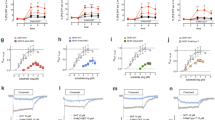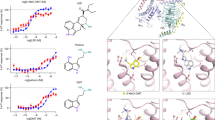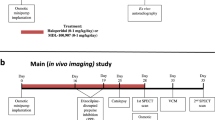Abstract
Recent electrophysiological studies in our laboratory have demonstrated a physiological interaction between 5-HT2A and metabotropic glutamate2/3 (mGlu2/3) receptors in the medial prefrontal cortex. Several behavioral studies have found that phenethylamine hallucinogens with partial agonist activity at 5-HT2A receptors induce head shakes when directly administered into the medial prefrontal cortex. The purpose of the present experiments was to examine whether an interaction occurs between mGlu2/3 and 5-HT2A receptors on a behavioral level using head shakes induced by phenethylamine hallucinogens as a model of 5-HT2A receptor activation. Administration of the mGlu2/3 agonist LY354740 (0.3–10 mg/kg, ip) suppressed head shakes induced by the phenethylamine hallucinogen 1-(2,5-dimethoxy-4-iodophenyl)-2-aminopropane (DOI). Conversely, administration of the mGlu2/3 antagonist LY341495 (1 mg/kg, ip) enhanced the frequency of DOI-induced head shakes. Taken together, these results raise the possibility that the psychomimetic properties of hallucinogenic drugs may be mediated in part, via increased glutamate release following activation of 5-HT2A receptors.
Similar content being viewed by others
Log in or create a free account to read this content
Gain free access to this article, as well as selected content from this journal and more on nature.com
or
References
Adler LE, Olincy A, Waldo M, Harris JG, Griffith J, Stevens K, Flach K, Nagamoto H, Bickford P, Leonard S, Freedman R . (1998): Schizophrenia, sensory gating, and nicotinic receptors. Schizophrenia Bull 24: 189–202
Aghajanian GK, Marek GJ . (1997): Serotonin induces excitatory postsynaptic potentials in apical dendrites of neocortical pyramidal cells. Neuropharmacology 36: 589–599
Aghajanian GK, Marek GJ . (1999): Serotonin-glutamate interactions: a new target for antipsychotic drugs. Neuropsychopharmacol 21: S122–S133
Altar CA, Wasley AM, Neale RF, Stone GA . (1986): Typical and atypical antipsychotic occupancy of D2 and S2 receptors: An autoradiographic analysis in rat brain. Brain Res Bull 16: 517–525
Alvaro JD, Aghajanian GK, Marek GJ . (1998): μ-Opiate agonists block head shakes induced by the serotonin2A agonist DOI. Soc Neurosci Abstr 24: 1369
Amsterdam JD . (1992): Gepirone, a selective serotonin (5-HT1) partial agonist in the treatment of major depression. Prog Neuro-Psychopharmacol & Biol-Psychiat 16: 271–280
Arnt J, Hyttel J . (1989): Facilitation of 8-OHDPAT-induced forepaw treading of rats by the 5-HT2 agonist DOI. European Journal of Pharmacology 161: 45–51
Battaglia G, Monn JA, Schoepp DD . (1997): In vivo inhibition of veratridine-induced release of excitatory amino acids by the group II metabotropic agonist LY354740 in rats. Neurosci Lett 229: 161–164
Bedard P, Pycock CJ . (1977): ‘Wet-dog’ shake behaviour in the rat: a possible quantitative model of central 5-hydroxytryptamine activity. Neuropharmacology 16: 663–670
Berendse HW, Groenewegen HJ . (1991): Restricted cortical termination fields of the midline and intralaminar thalamic nuclei in the rat. Neuroscience 42: 73–102
Blue ME, Yagaloff KA, Mamounas LA, Hartig PR, Molliver ME . (1988): Correspondence between 5-HT2 receptors and serotonergic axons in rat neocortex. Brain Res 453: 315–328
Bodkin JA, Zornberg GL, Lukas SE, Cole JO . (1995): Buprenorphine treatment of refractory depression. Journal of Clinical Psychopharmacology 15: 49–57
Buckholtz NS, Zhou D, Freedman DX . (1988): Serotonin2 agonist administration down-regulates rat brain serotonin2 receptors. Life Sciences 42: 2439–2445
Carlson ET, Simpson MM . (1963): Opium as a tranquilizer. American Journal of Psychiatry 120: 112–117
Cartmell J, Monn JA, Schoepp DD . (1999): The mGlu2/3 receptor agonists, LY354740 and LY379268, selectively attenuate phencyclidine versus d-amphetamine motor behavior in rats. J Pharmacol Exp Ther 291: 161–170
Ceulemans DLS, Gelders YG, Hoppenbrouwers M-LJA, Reyntjens AJM, Janssen PAJ . (1985): Effect of serotonin antagonism in schizophrenia: A pilot study with setoperone. Psychopharmacol 85: 329–332
Colpaert FC, Janssen PAJ . (1983): The head-twitch response to intraperitoneal injection of 5-hydroxytryptophan in the rat: antagonist effects of purported 5-hydroxytryptamine antagonists and of pirenperone, an LSD antagonist. Neuropharmacol 22: 993–1000
Colpaert FC, Niemegeers CJE, Janssen PAJ . (1982): A drug discrimination analysis of lysergic acid diethylamide (LSD): In vivo agonist and antagonist effects of purported 5-hydroxytryptamine antagonists and of pirenperone, a LSD-antagonist. J Pharmacol Exp Ther 221: 206–214
Comfort A . (1977): Morphine as an antipsychotic? Clinical Toxicology 11: 383–386
Conn PJ, Pin J-P . (1997): Pharmacology and functions of metabotropic glutamate receptors. Annu Rev Pharmacol Toxicol 37: 205–237
Corne SJ, Pickering RW, Warner BT . (1963): A method for assessing the effects of drugs on the central actions of 5-hydroxytryptamine. Br J Pharmacol 20: 106–120
Covey LS, Glassman AH, Stetner F . (1997): Major depression following smoking cessation. Am J Psychiatry 154: 263–265
Darmani NA, Martin BR, Pandey U, Glennon RA . (1990): Do functional relationships exist between 5-HT1A and 5-HT2 receptors? Pharmacol Behav Biochem 36: 901–906
de Boer T . (1996): The pharmacologic profile of mirtazepine. Journal of Clinical Psychiatry 57: 19–25
Eison AS, Eison MS, Torrente JR, Wright RN, Yocca FD . (1990): Nefazodone: preclinical pharmacology of a new antidepressant. Psychopharmacology Bulletin 26: 311–315
Gingrich JA, Zhou M, Sealfon S, Hen R . (1999): Mice lacking the 5-HT2A receptor are insensitive to many of the behavioral and physiological effects of hallucinogens. Soc Neurosci Abstr 25: 799
Glennon RA . (1990): Do classical hallucinogens act as 5-HT2 agonists or antagonists? Neuropsychopharmacol 3: 509–517
Gold MS, Donabedian RK, Dillard M, Slobetz FW, Riordan CE, Kleber HD . (1977): Antipsychotic effect of opiate agonists. The Lancet 2: 398–399
Granhoff MI, Lee L, Jackson A, Patel K, Martinez Y, Ashby CR, Wang RY . (1992a): The interaction of 5-HT1A and 5-HT2 receptors in the medial prefrontal cortex: Behavioral studies. Society for Neurosciences (Abstract) 18: 1380
Granhoff MI, Lee L, Jackson A, Patel K, Martinez Y, Ashby CR, Wang RY . (1992b): The interaction of 5-HT1A and 5-HT2 receptors in the medial prefrontal cortex: Behavioral studies. Soc Neurosci (Abstr) 18: 1380
Gudelsky GA, Koenig JI, Meltzer HY . (1986): Thermoregulatory responses to serotonin (5-HT) receptor stimulation in the rat. Evidence for opposing roles of 5-HT2 and 5-HT1A receptors. Neuropharmacol 25: 1307–1313
Haddjeri N, Blier P, deMontigny C . (1998): Long-term antidepressant treatments result in a tonic activation of forebrain 5-HT1A receptors. J Neurosci 18: 10150–10156
Jakab RL, Goldman-Rakic PS . (1998): 5-HT2A serotonin receptors in the primate cerebral cortex: Possible site of action of hallucinogens in pyramidal cell apical dendrites. Proc Natl Acad Sci USA 95: 735–740
Janssen PAJ, Niemegeers CJE, Awouters F, Schellenkens KHL, Megens AAHP, Meert TF . (1988): Pharmacology of risperidone (R 64 766):, a new antipsychotic with serotonin-S2 and dopamine-D2 antagonistic properties. J Pharmacol Exp Ther 244: 685–693
Kim H-S, Park I-S, Park W-K . (1998): NMDA receptor an tagonists enhance 5-HT2 receptor-mediated behavior, head-twitch response, in mice. Life Sci 63: 2305–2311
Kingston AE, Ornstein PL, Wright RA, Johnson BG, Mayne NG, Burnett JP, Belagaje R, Wu S, Schoepp DD . (1998): LY341495 is a nanomolar potent and selective antagonist of group II metabotropic glutamate receptors. Neuropharmacology 37: 1–12
Lopez-Gimenez JF, Mengod G, Palacios JM, Vilaro MT . (1997): Selective visualization of rat brain 5-HT2A receptors by autoradiography with [3H]MDL 100,907. Naunyn-Schmiedeberg's Arch Pharmacol 356: 446–454
Lucki I, Minugh-Purvis N . (1987): Serotonin-induced head shaking behavior in rats does not involve receptors located in the frontal cortex. Brain Res. 420: 403–406
Lucki I, Nobler MS, Frazer A . (1984): Differential actions of serotonin antagonists on two behavioral models of serotonin receptor activation in the rat. J Pharmacol Exp Ther 228: 133–139
Marek GJ, Aghajanian GK . (1996): LSD and the phenethylamine hallucinogen DOI are potent partial agonists at 5-HT2A receptors on neurons in the rat piriform cortex. J Pharmacol Exp Ther 278: 1373–1382
Marek GJ, Gewirtz JC . (1999): Serotonin2A receptor-induced EPSCs in layer V pyramidal cells of prefrontal cortex: block by lesions of medial thalamus. Soc for Neurosci Abstr 25: 449
Marek GJ, McDougle CJ, Price LH, Seiden LS . (1992): A comparison of trazodone and fluoxetine: implications for a serotonergic mechanism of antidepressant action. Psychopharmacol 109: 2–11
Marek GJ, Wright RA, Schoepp DD, Monn JA, Aghajanian GK . (2000): Physiological antagonism between 5-hydroxytryptamine2A and group II metabotropic glutamate receptors in prefrontal cortex. J Pharmacol Exp Ther 292: 76–87
McKenna DJ, Nazarali AJ, Himeno A, Saavedra JM . (1989): Chronic treatment with (±)DOI, a psychotomimetic 5-HT2 agonists downregulates 5-HT2 receptors in rat brain. Neuropsychopharmacol 2: 81–87
Meltzer HY . (1999): The role of serotonin in antipsychotic drug action. Neuropsychopharmacol 21: 106S–115S
Meltzer HY, Matsubara S, Lee J-C . (1989): Classification of typical and atypical antipsychotic drugs on the basis of dopamine D-1, D-2 and serotonin2 pKi values. J Pharmacol Exp Ther 251: 238–246
Moghaddam B, Adams B, Verma A, Daly D . (1997): Activation of glutamatergic neurotransmission by ketamine: A novel step in the pathway from the NMDA receptor blockade to dopaminergic and cognitive disruptions associated with the prefrontal cortex. J Neurosci 17: 2921–2927
Moghaddam B, Adams BW . (1998): Reversal of phencyclidine effects by a group II metabotropic glutamate receptor agonists in rats. Science 281: 1349–1352
Monn JA, Valli MJ, Massey SM, Hansen MM, Kress TJ, Wepsiec JP, Harkness AR, Grutsch JL, Wright RA, Johnson BG, Andis SL, Kingston A, Tomlinson R, Lewis R, Griffey KR, Tizzano JP, Schoepp DD . (1999): Synthesis, pharmacological characterization, and molecular modeling of heterobicyclic amino acids related to (+)-2-aminobicyclo[3.1.0]hexane-2,6-dicarboxylic acid (LY354740): Identification of two new potent, selective and systemically active agonists for group II metabotropic glutamate receptors. J Med Chem 42: 1027–1040
Monn JA, Valli MJ, Massey SM, Wright RA, Salhoff CR, Johnson BG, Howe T, Alt CA, Rhodes GA, Robey RL, Griffey KR, Tizzano JP, Kallman MJ, Helton DR, Schoepp DD . (1997): Design, synthesis, and pharmacological characterization of (+)-2-aminobicyclo[3.1.0]hexane-2,6-dicarboxylic acid (LY354740): A potent, selective, and orally active group 2 metabotropic glutamate receptor agonist possessing anticonvulsant and anxiolytic properties. J Med Chem 40: 528–537
Newman-Tancredi A, Gavaudan S, Conte C, Chaput C, Touzard M, Verriele L, Audinot V, Millan MJ . (1998): Agonist and antagonist actions of antipsychotic agents at 5-HT1A receptors: a [35S]GTPγS binding study. Eur J Pharmacol 355: 245–256
O'Brien CP, Woody GE, McLellan AT . (1984): Psychiatric disorders in opioid-dependent patients. Journal of Clinical Psychiatry 45: 9–13
Ohishi H, Neki A, Mizuno N . (1997): Distribution of a metabotropic glutamate receptor, mGluR2, in the central nervous system of the rat and mouse: an immunohistochemical study with a monoclonal antibody. Neuroscience Res 30: 65–82
Ohishi H, Shigemoto R, Nakanishi S, Mizuno N . (1993a): Distribution of the messenger RNA for a metabotropic glutamate receptor, mGluR2, in the central nervous system of the rat. Neuroscience 53: 1009–1018
Ohishi H, Shigemoto R, Nakanishi S, Mizuno N . (1993b): Distribution of the mRNA for a metabotropic glutamate receptor (mGluR3) in the rat brain: an in situ hybridization study. J Comp Neurol 335: 252–266
Peroutka SJ, Lebovitz RM, Snyder SH . (1981): Two distinct central serotonin receptors with different physiological function. Science 212: 827–829
Pompeiano M, Palacios JM, Mengod G . (1994): Distribution of the serotonin 5-HT2 receptor family mRNAs: comparison between 5-HT2A and 5-HT2C receptors. Mol Brain Res 23: 163–178
Pranzatelli MR . (1990): Evidence for involvement of 5-HT2 and 5-HT1C receptors in the behavioral effects of the 5-HT agonist 1-(2,5-dimethoxy-4-iodophenyl aminopropane)-2 (DOI). Neurosci Lett 115: 74–80
Raghupathi RK, Artymyshyn R, McGonigle P . (1996): Regional variability in changes in 5-HT2A receptor mRNA levels in rat brain following irreversible inactivation with EEDQ. Mol Brain Res 39: 198–206
Rasmussen K, Aghajanian GK . (1988): Potency of antipsychotics in reversing the effects of a hallucinogenic drug on locus coeruleus neurons correlates with 5-HT2 binding affinity. Neuropsychopharmacology 1: 101–107
Schoepp DD, Johnson BG, Wright RA, Salhoff CR, Mayne NG, Wu S, Cockerham SL, Burnett JP, Belagaje R, Bleakman D, Monn JA . (1997): LY354740 is a potent and highly selective group II metabotropic glutamate receptor agonist in cells expressing human glutamate receptors. Neuropharmacology 36: 1–11
Schoepp DD, Monn JA, Marek GJ, Aghajanian GK, Moghaddam B . (1999): LY354740: A systemically active mGlu2/3 receptor agonist. CNS Drug Reviews 5: 1–12
Schreiber R, Brocco M, Audinot V, Gobert A, Veiga S, Millan MJ . (1995): 1-(2,5-Dimethoxy-4 iodophenyl)-2-aminopropane)-induced head-twitches in the rat are mediated by 5-hydroxytryptamine (5-HT)2A receptors: Modulation by novel 5-HT2A/2C antagonists, D1 antagonists and t-HT1A agonists. J Pharmacol Exp Ther 273: 101–112
Titeler M, Lyon RA, Glennon RA . (1988): Radioligand binding evidence implicates the brain 5-HT2 receptor as a site of action for LSD and phenethylamine hallucinogens. Psychopharmacol 94: 213–216
Tizabi Y, Russell LT, Johnson M, Darmani NA . (1999): Head-twitch response induced by DOI is attenuated by nicotine pretreatment. Soc Neurosci Abstr 25: 60
Vetulani J, Bednarczyk B, Reichenberg K, Rokosz A . (1980): Head twitches induced by LSD and quipazine: similarities and differences. Neuropharmacol 19: 155–158
Vollenweider FX, Vollenweider-Scherpenhuyzen MFI, Babler A, Vogel H, Hell D . (1998): Psilocybin induces schizophrenia-like psychosis in humans via a serotonin-2 agonist action. NeuroReport 9: 3897–3902
Wander TJ, Nelson A, Okazaki H, Richelson E . (1986): Antagonism by antidepressants of serotonin S1 and S2 receptors of normal human brain in vitro. Eur J Pharmacol 132: 115–121
Wilcox CS, Ferguson JM, Dale JL, Heiser JF . (1996): A double-blind trial of low- and high-dose ranges of gepirone-ER compared with placebo in the treatment of depressed outpatients. Psychopharmacol Bull 32: 335–342
Willins DL, Deutch AY, Roth BL . (1997): Serotonin 5-HT2A receptors are expressed on pyramidal cells and interneurons in the rat cortex. Synapse 27: 79–82
Willins DL, Meltzer HY . (1997): Direct injection of 5-HT2A receptor agonists into the medial prefrontal cortex produces a head-twitch response in rats. J Pharmacol Exp Ther 282: 699–706
Wing LL, Tapson GS, Geyer MA . (1990): 5-HT-2 mediation of acute behavioral effects of hallucinogens in rats. Psychopharmacol 100: 417–425
Wright DE, Seroogy KB, Lundgren KH, Davis BM, Jennes L . (1995): Comparative localization of serotonin1A, 1C, and 2receptor subtype mRNAs in rat brain. J Comp Neurol 351: 357–373
Yap CY, Taylor DA . (1983): Involvement of 5-HT2 receptors in the wet-dog shake behaviour induced by 5-hydroxtryptophan in the rat. Neuropharmacol 22: 801–804
Acknowledgements
Supported by PHS Grants K08 MH01551, a NARSAD Young Investigator Award (1999 Fairfax Investigator Award), and the State of Connecticut (G.J.M.). We thank Drs. Darryle Schoepp and James Monn for valuable discussions. We appreciate Dr. Younglim Lee's review of this manuscript. We thank Nigel Henry, Sara Heron, Andrew Kwak, Megan Lennon, and Boting Zhang for technical assistance. We also thank Leslie Rosello for secretarial assistance.
Author information
Authors and Affiliations
Corresponding author
Rights and permissions
About this article
Cite this article
Gewirtz, J., Marek, G. Behavioral Evidence for Interactions between a Hallucinogenic Drug and Group II Metabotropic Glutamate Receptors. Neuropsychopharmacol 23, 569–576 (2000). https://doi.org/10.1016/S0893-133X(00)00136-6
Received:
Revised:
Accepted:
Issue date:
DOI: https://doi.org/10.1016/S0893-133X(00)00136-6
Keywords
This article is cited by
-
Fully automated head-twitch detection system for the study of 5-HT2A receptor pharmacology in vivo
Scientific Reports (2019)
-
Effects of the synthetic psychedelic 2,5-dimethoxy-4-iodoamphetamine (DOI) on ethanol consumption and place conditioning in male mice
Psychopharmacology (2019)
-
Chronic treatment with a metabotropic mGlu2/3 receptor agonist diminishes behavioral response to a phenethylamine hallucinogen
Psychopharmacology (2019)



